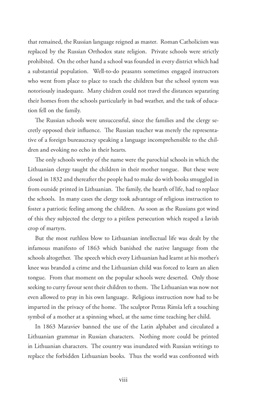
viii
that remained, the Russian language reigned as master. Roman Catholicism was
replaced by the Russian Orthodox state religion. Private schools were strictly
prohibited. On the other hand a school was founded in every district which had
a substantial population. Well-to-do peasants sometimes engaged instructors
who went from place to place to teach the children but the school system was
notoriously inadequate. Many chidren could not travel the distances separating
their homes from the schools particularly in bad weather, and the task of education fell on the family.
The Russian schools were unsuccessful, since the families and the clergy secretly
opposed their influence. The Russian teacher was merely the representative
of a foreign bureaucracy speaking a language incomprehensible to the children
and evoking no echo in their hearts.
The only schools worthy of the name were the parochial schools in which the
Lithuanian clergy taught the children in their mother tongue. But these were
closed in 1832 and thereafter the people had to make do with books smuggled in
from outside printed in Lithuanian. The family, the hearth of life, had to replace
the schools. In many cases the clergy took advantage of religious instruction to
foster a patriotic feeling among the children. As soon as the Russians got wind
of this they subjected the clergy to a pitiless persecution which reaped a lavish
crop of martyrs.
But the most ruthless blow to Lithuanian intellectual life was dealt by the
infamous manifesto of 1863 which banished the native language from the
schools altogether. The speech which every Lithuanian had learnt at his mother's
knee was branded a crime and the Lithuanian child was forced to learn an alien
tongue. From that moment on the popular schools were deserted. Only those
seeking to curry favour sent their children to them. The Lithuanian was now not
even allowed to pray in his own language. Religious instruction now had to be
imparted in the privacy of the home. The sculptor Petras Rimša left a touching
symbol of a mother at a spinning wheel, at the same time teaching her child.
In 1863 Maraviev banned the use of the Latin alphabet and circulated a
Lithuanian grammar in Russian characters. Nothing more could be printed
in Lithuanian characters. The country was inundated with Russian writings to
replace the forbidden Lithuanian books. Thus the world was confronted with